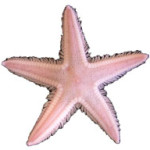
Didemnum sp.
Tunicates are a group of marine animals that spend most of their short lives attached to docks, rocks or the undersides of boats. To most people they look like small, coloured plantlike growth. It often comes as a surprise to learn that they are actually more closely related to vertebrates like ourselves, than to most other invertebrate animals.
Nothing can be seen of a vertebrate relationship in the adult animals, but the tadpole-like larva has a notochord, (a stiff rod) in its tail. After hatching, this little creature, rarely more than 5mm long, swims for a few hours to find a spot somewhere on a solid surface. It attaches itself to the surface with its head, and within minutes resorption of the larva tail commences and the sea squirt will stay on that same spot for all its life.
A tunicate is built like a barrel, and is so named because the outer layer of the body wall is a tough “tunic”, made of a substance that is almost identical with cellulose. They live by passing seawater through their bodies. In essence the animal consists of a double sac with two siphons. Seawater is pumped slowly through one siphon, sieved through the inner sac for plankton and organic detritus, and the filtered seawater is pumped out again through the second siphon, the atrium. When removed from the water, they continue to expel water through the atrium, hence the common name “sea squirt”. The class name Ascidiacea, comes from the Greek word askidion, a leather wine flask with a tough outer casing around its body. Sea squirts vary greatly in form, from simple sac-like creatures on the underside of rocks, to complex brightly coloured colonial species with hundreds of minute individuals.
Given the tunicate’s preference for living on artificial structures and its fouling and smothering capabilities, its main claim to fame, or rather notoriety is as a pest. Mussel growers, for example, are concerned about the ability of the indicator to establish itself in mussel farming areas.
The Didemnum species of ascidians are an encrusting colonial species with a sponge-like appearance with a sponge-like appearance. They vary in colour but are commonly creams to yellow/brown. Overall, colonies may reach 30-46 cm long (12-18 inches). In essence they are single year organisms, developing the first year, then breeding and dying the following year.







Social Profiles